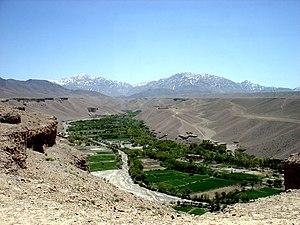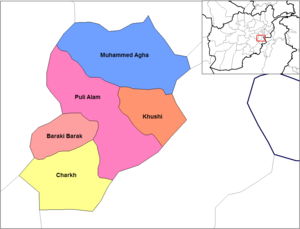Logar Province: Difference between revisions
the native name is in the infobox, no need to fight over what language it is in, Eastern Persian or Dari is the language spoken in Logar, not modern Persian, read the language articles |
No edit summary |
||
| Line 16: | Line 16: | ||
|timezone = UTC+4:30 |
|timezone = UTC+4:30 |
||
|free_type = [[Languages of Afghanistan|Main languages]] |
|free_type = [[Languages of Afghanistan|Main languages]] |
||
|free = [[Dari (Eastern Persian)|Dari]], [[Pashto]] |
|free = [[Dari (Eastern Persian)|Dari-Persian]], [[Pashto]] |
||
}} |
}} |
||
Revision as of 02:09, 2 February 2009
Logar is one of the 34 provinces of Afghanistan. It is located in the eastern zone, southeast of Kabul, and the geography of the province centers on the large Logar River which enters the province through the west and leaves to the north. Its capital is Pul-i-Alam. Logar is home to Tajiks, Pashtuns and Hazaras.[1] The exact demography is unknown, as there has not been a census for decades.
Politics
Logar is a generally religiously conservative province, although not to the extent of its southern neighbours. The province's political history is a microcosm of Afghanistan's recent turbulent past. During the period immediately prior to the US invasion of 2001, portions of the province were controlled by both the Taliban and the Northern Alliance. During the Jihad against Soviet occupation in the 1980s, Baraki Barak, Khushi, Charkh and Pule Alam districts were controlled by Jamiat e-Islami. Logar was known among Afghans as باب الجهاد' Bab al-Jihad', or 'the Gates of Jihad' because it became a fierce theatre of war between mujahideen groups and the Soviet army and it was the main supply route of Mujahideen coming from south and Pakistan and going towards Northern and Central Afghanistan. It is said that the largest single convoy of the Soviets consisting of more than 350 Tanks, Trucks, Oil Tankers and other vehicles was attacked and destroyed in Logar province in a combined operation of different Mujahideen factions.
The province also was home to several Al-Qaeda training bases during that time, although the residents of the province were reportedly unfriendly to the foreign fighters. Mohamad Agha district has long been a stronghold of the Hezb-i-Islami political party, which won seats in the 2005 parliamentary election[2], although the parliamentarians are not officially affiliated with the fugitive leader of Hezb-i-Islami, Gulbuddin Hekmatyar. Additionally, the Northern Alliance-affiliated Jamiat-i-Islami was in control of the province for several years after the fall of the Taliban government. The Taliban continued to operate in Logar Province after the fall of the Taliban government.[3][4] As recently as November 2008 the militant Taliban group led by Mavlvi Jalaluddin Haqani was operating in Logar Province.[5]
The Governor of the province was Abdullah Wardak until he was assassinated by car bomb on 13 September 2008. In October 2008 he was replaced by Attiqullah Lodeen, who has also been subject to armed attacks.[6]
Geography

Logar can be generally described as a relatively flat river valley in the north and central regions, surrounded by rugged mountains to the east, south, and southwest. The district of Azra, in the east, consists almost entirely of mountains, while travel to the Paktia Province to the south is limited to the Tera Pass, a 2896m high road that was recently completed as part of the international reconstruction effort in Afghanistan.
Although the government of Afghanistan recognizes the Azra district as being in Logar, many widely-accepted maps include it in the Paktia province to the south.
Security situation
While more stable than some of its neighbouring provinces in the country, Logar sees a constant high level of anti-government activity, primarily in the form of car bombs and rocket attacks on government, military and civil targets. Unlike portions of southwest Afghanistan, poppy production is nearly non-existent, due to terrain and weather conditions. Tribal land disputes are a source of unrest, as is the case across much of the country.[7]
Capital

Logar's capital is the city of Pul-i-Alam, located in the district of the same name. It sits on the main road running from Kabul south to Gardez and Khowst province, which borders Pakistan.
Pul-i-Alam has seen a significant amount of reconstruction since the fall of the Taliban. The main road to Kabul was completed in 2006, significantly reducing travel time to the national capital. Additional projects include numerous schools, radio stations, government facilities, and a major Afghan National Police base situated just south of the city.
Like most Afghan cities, there is little municipal planning or services. Electricity is provided by diesel generators, and wells are the primary source of drinking water.
Districts

Until 2005 the district was administratively subdivided into 5 districts, in that year the province gained Azra District from neighbouring Paktia Province, also part of Charkh District was split off into the new district of Kharwar.
| District | Capital | Population | Area[8] | Notes |
|---|---|---|---|---|
| Azra | Shifted from Paktia Province in 2005 | |||
| Baraki Barak | ||||
| Charkh | Sub-divided in 2005 | |||
| Kharwar | Created in 2005 within Charkh District | |||
| Khoshi | ||||
| Mohammad Agha | ||||
| Pul-i-Alam |
References
- ^ Cite error: The named reference
CCSwas invoked but never defined (see the help page). - ^ Pajhwok Afghan News, no longer valid 24 January 2009
- ^ "Taliban briefly control district in Logar" Pajhwok Afghan News 3 June 2008, accessed 24 January 2009
- ^ "Taliban attack police headquarters in Logar" Pajhwok Afghan News 25 November 2006, accessed 24 January 2009
- ^ "Suspected Taliban commander arrested in Logar" Pajhwok Afghan News 3 November 2008, accessed 24 January 2009
- ^ "Logar governor escapes attempt on life" Pajhwok Afghan News 30 October 2008, accessed 24 January 2009
- ^ "Commission to take stock of land dispute" Pajhwok Afghan News 18 March 2006, accessed 24 January 2009
- ^ Afghanistan Geographic & Thematic Layers
